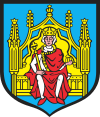Grodzisk Wielkopolski
| Grodzisk Wielkopolski | |||
|---|---|---|---|
|
Shopping street (ulica Szeroka) | |||
| |||
 Grodzisk Wielkopolski | |||
| Coordinates: 52°14′N 16°22′E / 52.233°N 16.367°ECoordinates: 52°14′N 16°22′E / 52.233°N 16.367°E | |||
| Country | Poland | ||
| Voivodeship | Greater Poland | ||
| County | Grodzisk Wielkopolski County | ||
| Gmina | Gmina Grodzisk Wielkopolski | ||
| City rights | 1303 | ||
| Government | |||
| • Mayor | Henryk Szymański | ||
| Area | |||
| • Total | 18.09 km2 (6.98 sq mi) | ||
| Population (2006) | |||
| • Total | 13,703 | ||
| • Density | 760/km2 (2,000/sq mi) | ||
| Time zone | CET (UTC+1) | ||
| • Summer (DST) | CEST (UTC+2) | ||
| Postal code | 62-065 | ||
| Area code(s) | +48 61 | ||
| Car plates | PGO | ||
| Website | http://www.grodzisk.wlkp.pl | ||
Grodzisk Wielkopolski [ˈɡrɔd͡ʑisk vʲɛlkɔˈpɔlskʲi] is a town in western Poland, in Greater Poland Voivodeship (Wielkopolskie), with a population of 13,703 (2006). It is 43 kilometres (27 mi) south-west of Poznań, the voivodeship capital. It is the seat of Grodzisk Wielkopolski County, and also of the smaller administrative district called Gmina Grodzisk Wielkopolski. The suffix "Wielkopolski" distinguishes it from the town of Grodzisk Mazowiecki in eastern Poland.
History
The settlement was first mentioned in 1257 by the name of Grodisze in a document by Przemysł I of Greater Poland. It was referred to as a village belonging to the Cistercians.
The exact date when the town received its charter is unknown. Doucments say that the town definitely had its town charter in 1303.
The first Jews settled in the town at the beginning of the 16th century. The first document to back this up was in 1505, mentioning the Jew Abraham of Grodzisk In Yiddish and Hebrew, the town is known as גרידץ (Gritz or Gritza)
In 1563, the Stanisław Ostroróg school was founded.
In 1593, the census for Grodzisk Wielkopolski said that the population was approximately 1,160. The town charter was renewed with the inclusion of a new town about 150 metres from the old town. In 1601, the first privileges for the brewery were awarded. The town quickly became important for the production of beer (Grodziskie style). At the end of the 18th century, there were 53 breweries in the city. In 1626, the mayor of the city changed to the Opaliński family. They remained as mayors until 1775.
In 1793, the city became part of Prussia. From 1887 to 1918, Grätz, as it was called during this time, was the seat for Kreis Grätz. It became part of Poland again in 1920, and was until 1932 the seat of a county or powiat.
During World War II, the city came under German control. In Młyniewo, a nearby village, a transit camp was formed for onward transport to concentration camps, initially for Jews and later for Poles and other prisoners of war. On January 27, 1945, the city was retaken by the Red Army.
After World War II, beer production declined and was discontinued in 1993. In 1999, Grodzisk again became a powiat seat when the powiats were reintroduced in the Polish administrative reforms.
As well as Grodziskie beer, Grodzisk is also known for its mineral water. A commemorative pump stands in the central market square in front of the town hall.
International relations
Twin towns — Sister cities
Grodzisk Wielkopolski is twinned with:
Famous people
- Rudolf Mosse (1843–1920), publisher and philanthropist
- Albert Mosse (1846–1925), German judge and legal scholar
- Michał Drzymała (1857–1937), Polish national activist
- Samuel Herzfeld 1875
- Hans Heinrich Müller (1879–1951), architect
Sport
- Dyskobolia Grodzisk Wielkopolski - football team playing in the Orange Ekstraklasa
External links
| Wikimedia Commons has media related to Grodzisk Wielkopolski. |


_COA.svg.png)